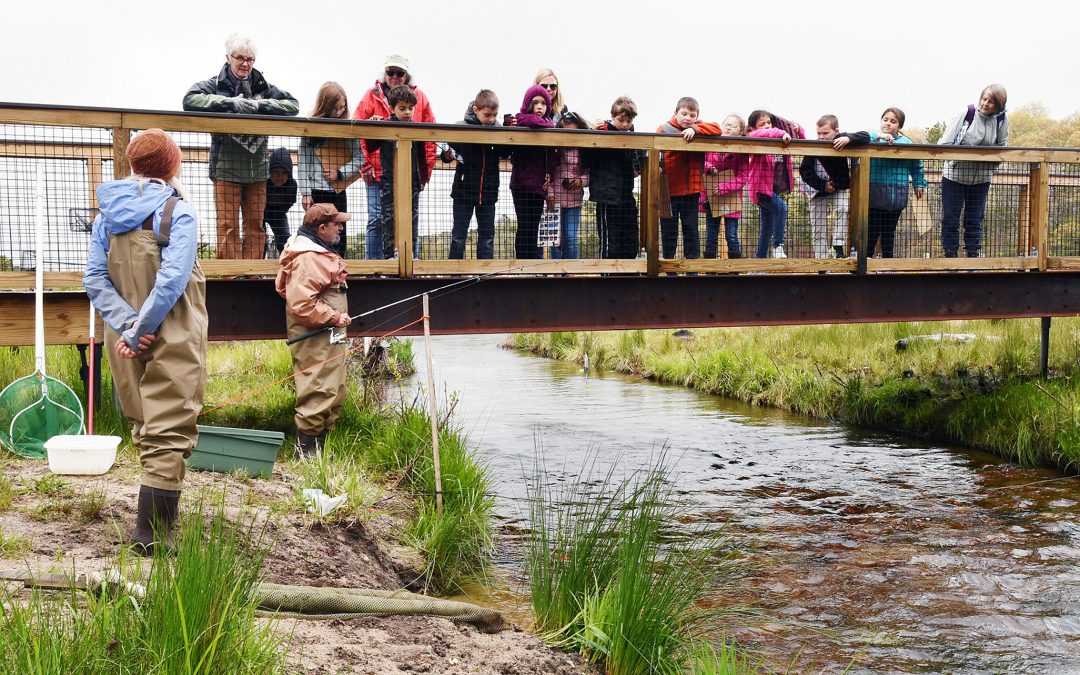By CHRISTINE LYNCH
While walking along with your child, you hear some shrill alarm-like cries coming from overhead. Looking up, you see the wide wingspan of a soaring bird, and then a little voice asks, “What bird is that?” Most Cape parents are familiar with the ospreys taking up residency in jumbled nests atop utility poles, so you can answer that one.
As children start learning about something, they’re hungry to hear more and more. One question likely leads to others, so this new bird sighting could lead to something like, “Is it like a hawk or eagle?” “Does it have babies?” Then, because the big nest on that pole has been empty all winter, “Where did it come from, and why does it leave?” When parents don’t know, books or the internet can provide information. Another surefire way to learn more is to get outside and observe nature firsthand.
Going a step further, you might consider doing citizen science, also called community science. This concept encourages regular people (that is, non-scientists) to help collect data by doing observations or measurements. Your results get sent to scientific or research organizations and greatly increase the scope of data gathered for environmentalists and scientists, who often have limited time and resources. You can choose the level of commitment you want to spend on any project and include your children.
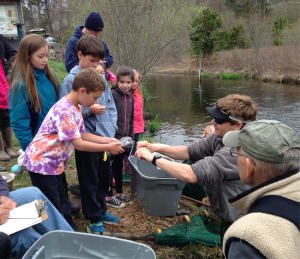
Photograph courtesy of the Coonamessett River Trust.
Matt Kellogg, in the tie-dye shirt, and Sam Kellogg behind him participate in the spring 2017 herring tagging on the Coonamessett River.
Community science osprey projects on Cape Cod are being done by The 300 Committee and Mass Audubon, among other groups. Both these important environmental groups rely on community involvement. By getting involved, you and your child can better understand the behavior of these wild birds.
If instead your child has a fascination with, say, butterflies (“How do birds and butterflies fly?” “What do butterflies eat?” “Do butterflies come from eggs, too?”) you might help the North American Butterfly Association. Information for this organization is found at www.naba.org. Also, visit www.butterfliesandmoths.org; or Monarchwatch.org for help with the declining numbers of monarch butterflies. Collected information helps monitor their habitats along with the effects of climate change.
Whatever interests your family—squirrels, ladybugs, beaches, vernal pools, astronomy—there is a citizen science project looking for participation by inquisitive minds. You can find specific sites such as www.squirrelproject.org, www.lostladybug.org, or www.jellywatch.org, which gathers information on jellyfish. Or there are general sites that offer links to many types of projects such as www.zooniverse.org. Some are computer-based or use an app. Most are free, although some tell you up front that they may require equipment or other materials, and what any costs might be. Besides the knowledge gained, contributing to these projects helps the planet and proves that being interested in our world is a good thing, while building lifelong memories with your loved ones.
Another possibility is to plan a family vacation around an ongoing study or research project. Besides promising adventures, these eco-friendly excursions offer learning that lasts a lifetime. You can choose to stay locally, go to another state or head to wilderness locales. Getaways range from photographing flowers, monitoring plant diversity, wildlife habitats, the health of coral reefs, to measuring plastic particulates in sea water. This is a growing industry with a vast amount of options. You can start by searching online to see what type of jaunt would work for your family’s ages, the time allotment you can travel, and your budget. A few examples include Lindblad Travel, in conjunction with the National Geographic Society, at www.expeditions.com; the Appalachian Mountain Club’s www.outdoors.org; and the California-based www.oceanicsociety.org.
But, right here on the Cape, an area rich in natural resources, several organizations rely on community scientists. There’s the Coonamessett River Trust, Waquoit Bay National Estuarine Research Reserve, and the Buzzards Bay Coalition, to name just a few. Here are some of the places and projects that can use you and your family to get involved.
Coonamessett River Trust
Established in 2006, the Coonamessett River Trust strives to restore and maintain the natural balance of this ecologically rich area. Supported by many local organizations and businesses, this once-commercial cranberry bog is being transformed back to a meandering herring river surrounded by meadowland. Their website (www.crivertrust.org) explains the phases of this undertaking, showing the initial stages, current results and future directions. Information also is posted on signage along the paths.
Researchers and volunteers have donated their time, resources and considerable skills to the project. Now, more people enjoy peaceful walks along groomed paths as the work continues. For anyone interested in helping the restoration efforts, there are a few ways to contribute. Wendi Buesseler, president of The Coonamessett River Trust, said the improvements now allow the Coonamessett to return to its natural flow. Removal of the dams especially let the herring run with much greater ease.
Helping the Herring
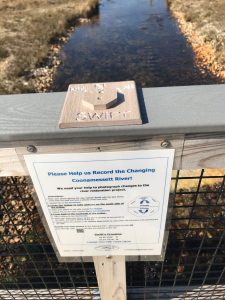
The picture post at Swift’s Crossing
Ms. Buesseler said the group asks for help with the annual herring counts, which is a great aid to the researchers who could never monitor this significant migration on their own. As the herring are making their annual run up the Coonamessett heading to their spawning ponds, volunteer counters stand on a river crossing and count all herring they see. These counts, along with the time of day and conditions around that site, are indispensable to researchers.
Another herring project occurs each year as herring are tagged to monitor the health of the herring stocks as well as the water quality. The public is invited to watch as the trained taggers attach a passive “rice-sized” tag, then release the herring back into the river’s flow. Ms. Buesseler said that when a herring passes an antenna, the tag’s code is recorded. This lets us “see where the herring goes, how long it takes to get upriver, and to document where they might have had any problems.” And it’s all directly from the fish’s viewpoint.
She mentioned that collected data showed that there was a significant clog by a culvert under John Parker Road. They swiftly began work, along with the town DPW, to open up that underpass. The group now is working with the town to begin work on the upper bog.
School kids and others can Adopt a Herring. Many aspects of STEM lessons can be witnessed here. People who have adopted a fish can track where the little one’s route goes as he swims and shows how he’s doing, whether he stayed safe or was plucked away by a predator, which can happen.
Post a Picture: One other simple yet vital aid to the researchers is for people to bring a smartphone as they walk along the paths, something many walkers do anyway. Midway along the Swift’s Crossing bridge, there is a picture post. A plaque with instructions asks people to snap photos as they face in the indicated eight directions (N-NE-E-SE-S-SW-W-NW). Then it asks that they turn the camera skyward to take a photo of the sky above. Save the photos, then upload them to the collection site located at picturepost.ou.edu. The compiled photos establish what the conditions were at that moment, thus helping researchers monitor the area through the seasons.
Waquoit Bay National Estuarine Research Reserve
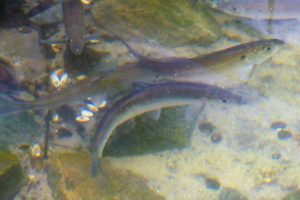
Photograph By GENE M. MARCHAND
Herring gather after having navigated a run.
WBNERR is another facility that greatly relies on public input. In fact, they also ask for citizen input at a picture post like the one on the Coonamessett River. To get to the WBNERR picture post, follow along one trail that skirts the bluff over Waquoit Bay. A short stone-covered trail descends gently to an open marsh. Instructions show where to hold your phone/camera to capture all eight directions, then how to link to the site picturepost.unh.edu, and to send them in your photos. Your help with this lets WBNERR staff keep tabs on 360 degrees of the changing landscape.
Nancy Church, their school and interpretive services coordinator, said that citizen science, “is a topic that we are interested in and hope to do more in the future.” She mentioned, “There are still a few longtime adult volunteers (such as their Waquoit BayWatchers) collecting water quality data at this time, but the facility is still closed except for the grounds.” Sadly, as of this writing, “In-person activities are on hold for now.” WBNERR won’t be recruiting new volunteers until state restrictions say it’s safe. In the past the public has helped with habitat mapping and collected data on endangered shorebird and breeding birds, horseshoe crab spawning, osprey activity, cottontails, trout, and fish surveys.
Even being closed, it’s worth a visit to stroll along the walking trails with seaward views of Waquoit Bay, Washburn Island and beyond. When able to re-open, WBNERR will offer school groups and the public hands-on learning experiences and interesting lectures and events. For information, visit www.waquoitbayreserve.org or phone 508-495-0495.
The Buzzards Bay Coalition
Buzzards Bay is yet another vital watershed in our area that is vulnerable to a growing population and climate effects. Noticing a decline in the water quality, the Buzzards Bay Coalition organized in 1987 and quickly took action. Ever since, they’ve kept watch over the bay, which measures about 28 miles long by eight miles wide, and its surrounding waterways and land. Many of the projects are run in conjunction with researchers from scientific labs in Woods Hole.
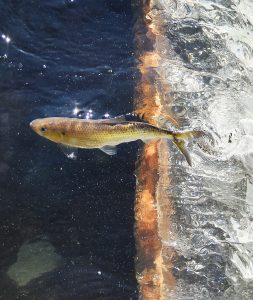
A river herring swims upstream to lay its eggs in the Coonamessett River.
Their volunteer-based Baywatchers program started in 1992. Colin Zeigler, volunteer coordinator, said via email, “Our Baywatchers program includes several families that work together to help monitor water quality.” He mentioned “more than 1,000 local residents have volunteered as Baywatchers.” In the summers, they go out one morning per week to various sites, “These citizen scientists test key aspects of the water’s health.” These include dissolved oxygen, temperature, salinity, water clarity and general weather conditions.
Additionally, four times during the summer, Baywatchers collect water samples to be analyzed by the Ecosystems Center, Marine Biological Laboratory, in Woods Hole. This work, “conducted in accordance with a Quality Assurance Project Plan approved by the US Environmental Protection Agency and the Massachusetts Department of Environmental Protection,” samples for nitrogen, phosphorus and algal pigments. These key factors help to formulate future policies geared to improving bay health.
See their website (savebuzzardsbay.org) for information “about the opportunities that we offer for families!”
Even with the best of intentions, people may make errors when collecting or recording their finds. As precautions, the researchers mentioned that they do verification checks for the data collected by non-scientists. Rachel Jakuba, science director working with the Buzzards Bay Coalition, said in an email message, “We take a lot of measures to verify our volunteer data that are described in detail in our Quality Assurance Project Plan” (mentioned above). She added, “These include annual re-training of volunteers, comparing volunteer data with previous years, re-training volunteers when their data are unusual and doing a rigorous data review at the end of the season.”
Tony Williams, their director of monitoring, added, “Yes, and in addition, we do yearly checks of the equipment and kits that we hand out to the volunteers, calibrations, new reagents for the chemistry test each year, and set them up as a standard test kit and instructions where everyone uses identical equipment each year.”
Cape Cod Museum of Natural History
Located on expansive coastal lands in Brewster, the Cape Cod Museum of Natural History offers engaging exhibits and programs for children and adults. As with other research facilities, the museum welcomes volunteers and citizen scientists. A section of the museum’s Mission Statement states: “As befits a nature education center, we will explore our potential as a center for citizen scientists and amateur naturalists, and as a forum for informed discussion of important issues related to the natural world, especially on Cape Cod.” See www.ccmnh.org or call 508-896-3867.
The Maria Mitchell Association
Famously known as a pioneer in the field of the astronomy, Maria Mitchell lived and did her research on Nantucket. Now, her home and observatory are part of The Maria Mitchell Association. This organization honors her work with many astronomical and star-gazing programs, and it offers many interesting talks and events throughout the year.
Their property includes an extensive nature reserve people can experience. They also seek citizen scientists for ongoing studies, such as The Green Crab and FrogWatch USA. Each year in mid-May they ask birders from all over to Bird-Where-You-Are. Participants spend a designated day observing as many birds as possible and then reporting the sightings to the science center. See their website www.mariamitchell.org for information.
Some further ideas:
The 300 Committee (www.300committee.org) goes the extra mile preserving open land, supervising its condition, and providing public access where it’s possible. To do this, the land must be monitored and maintained, which offers opportunities for those wanting to help. Learn more on their website by clicking on Get Involved, Volunteer.
The Mass Audubon website (www.Massaudubon.org) points out: “community science volunteers provide critical support to our science staff, as well as to the wildlife themselves.”
NOAA-NMFS, Woods Hole (www.fisheries.noaa.gov). Go to the section on “Volunteering and Citizen Science.” It states, “By volunteering and conducting citizen science, you can preserve critical habitat, help scientists gather valuable data, and work towards a more sustainable future… We launched a NOAA Community of Practice on citizen science in 2013 that now includes more than 160 members and projects that have resulted in more than half a million volunteer hours per year. Information about many of these projects can be found in the Federal Crowdsourcing and Citizen Science Catalog.
Woods Hole Oceanographic Institution (whoi.edu) WHOI researchers also seek assistance on numerous projects, including work with the Buzzards Bay Coalition.
Marine Biological Laboratory (MBL.edu) Diana Kenney, Associate Director of Communications for the MBL, wrote an article (March 10, 2021, posted on the website’s blog) about the collaboration between the MBL, Buzzards Bay Coalition, and citizen scientists, known as the Baywatchers project. She also suggested, “There are a variety of projects that you can learn about on the Science Friday site www.sciencefriday.com/series/citizen-science/”.
SciStarter.org is another good site with many ideas that can be done right around your home. For example, within SciStarter type “Bumble Bee Watch” to monitor bee activity (bumblebeewatch.org) or Soil Collection to do soil analysis (whatsinyourbackyard.org). Another fun one is the continuing search for alien life, just type “SETI@home” (setiathome.berkeley.edu).
Other umbrella sites listing project ideas include: pbskids.org, Zooniverse.org, and the state’s mass.gov website includes this section: “Sign Up for Coastal Citizen Science.”

